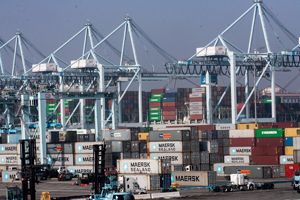
Even after dockworkers and shipping companies end their dispute, it could take months to clear the massive container backlog that has accumulated at the ports of Los Angeles and Long Beach.
The labor strife exacerbated longstanding delays in moving cargo off the docks, the result of endemic problems that might yet take years to remedy. The talks between the International Longshore and Warehouse Union, which negotiates for the dockworkers, and Pacific Maritime Association, which represents the shipping lines, have begun to focus attention on other long-term structural problems at the ports that have contributed to the massive backlog now accumulating.
Larger cargo ships calling on the ports, greater volume as a result of alliances formed among shipping lines, fewer trucks and drivers hauling containers and the muddled management of the trailers that move the containers are persistent problems. As a result, companies that import and export through the port complex can expect ongoing delays and frustration well after a labor contract is finalized.
Officials with the Port of Los Angeles estimated last week that it would take as much as two months to clear the inventory of containers sitting on ships and on the docks once labor negotiations end. Representatives of the Port of Long Beach said they expected it to be at least a month before activity returned to normal.
But those estimates might be optimistic.
Wally Baker, who heads the Jobs 1st Alliance, a non-profit that advocates for construction projects at the ports to generate jobs and make the facilities more competitive, said he expects it would take three to six months to clear out containers now on the docks and ships anchored offshore.
“Last time, in 2002, it took a few months to clear out,” he said in reference to the 2002 lockout that shut the ports down.
John McLaurin, president of the Pacific Merchant Shipping Association, a San Francisco trade group for shipping lines and terminal owners-operators, said congestion issues have put the operability of all the West Coast ports under the magnifying glass.
“It’s a system that works pretty well, but there are times when the system breaks down and we’re in one of those situations,” he said.
“It is raising awareness of the fragile nature of the transportation infrastructure that links us with markets around world,” said Jock O’Connell, an international trade adviser with Beacon Economics near LAX. “What we’re seeing on the West Coast now is a strain on the maritime supply chain that comes close to breaking.”
Managing flow
Among the persistent problems plaguing the ports is the management of truck trailers, referred to as chassis, that connect to trucks and carry the containers. There is a shortage of chassis – whether by design or circumstance is a matter of dispute – that has slowed the movement of containers from the ports.
A new management system is set to be implemented next month that could smooth the process. Three companies whose business is moving chassis around the port complex have agreed to form what is called a pool of pools, a single entity that will move the chassis among the terminals.
“The operations group will rebalance the number of chassis every couple of weeks to ensure that each terminal has access to an appropriate number of chassis,” said Bill Shea, chief executive of Direct Chassis Link Inc. of Charlotte, N.C., the largest of the chassis management businesses operating at the ports. “On a daily basis, the group will move the chassis across the complex to support each terminal.”
Shea said his company was buying 2,000 more chassis that would be delivered to the ports later this year, bringing the total at the complex to around 90,000 – still shy of the 105,000 chassis that had been in use in previous years and not in time to help with the existing backlog.
More chassis and better management of them, however, is not enough to ensure a rapid return to normal.
Weston LaBar, executive director of the Harbor Trucking Association in Long Beach, which represents trucking companies serving the ports, said systems allowing truckers to move quickly through the complex remain poor. He said containers aren’t sorted efficiently at the ports and truckers are having to spend time locating the containers they are scheduled to pick up.
“Especially with the congestion now, when you’re picking up a container, and your container is buried, it slows the process down,” said LaBar, who wants to end the practice of closing terminal gates for an hour between shifts.
Still to be resolved are delays caused by the shipping alliances, which add efficiencies to the shipping process but create problems at the docks as workers spend time sorting comingled shipments.
“In the past, when ships were smaller and there were fewer alliances, this wasn’t as much of a problem as it is now,” said Lee Peterson, a spokesman for the Port of Long Beach.
